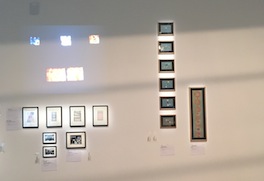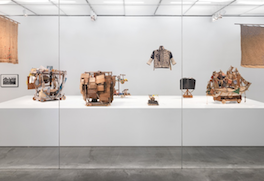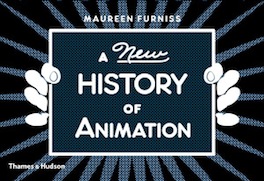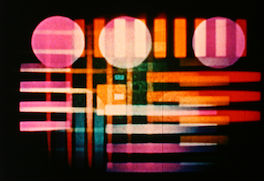You have no items in your cart.
-
Architecture of Life
01/31/2016 - 05/29/2016
Location: Berkeley Art Museum
Details >See Harry Smith’s String Figures in the Berkeley Art Museum’s “Architecture of Life.” The show, which is the inaugural exhibition in BAMPFA’s landmark new building, explores the ways that architecture—as concept, metaphor, and practice—illuminates various aspects of life experience: the nature of the self and psyche, the fundamental structures of reality, and the power of the imagination to reshape our world. Occupying every gallery in the new building, designed by Diller Scofidio + Renfro, the exhibition comprises over two hundred works of art in a wide range of media, as well as scientific illustrations and architectural drawings and models, made over the past two thousand years. Boundary-breaking, innovative, and radically interdisciplinary, the exhibition presents visually exquisite, rarely seen works in ways that suggest new connections and meanings.
-
Beat Generation
06/22/2016 - 10/03/2016
Location: Centre Pompidou
Details >The Centre Pompidou is to present Beat generation, a novel retrospective dedicated to the literary and artistic movement born in the late 1940s that would exert an ever-growing influence for the next two decades. The theme will be reflected in all the Centre’s activities, with a rich programme of events devised in collaboration with the Bibliothèque Public d’Information and Ircam: readings, concerts, discussions, film screenings, a colloquium, a young people’s programme at Studio 13/16, etc.
-
Exhibition: The Keeper
07/20/2016 - 10/02/2016
Location: New Museum of Contemporary Art
Details >“The Keeper” is an exhibition dedicated to the act of preserving objects, artworks, and images, and to the passions that inspire this undertaking. A reflection on the impulse to save both the most precious and the apparently valueless, it brings together a variety of imaginary museums, personal collections, and unusual assemblages, revealing the devotion with which artists, collectors, scholars, and hoarders have created sanctuaries for endangered images and artifacts. In surveying varied techniques of display, the exhibition also reflects on the function and responsibility of museums within multiple economies of desire.
-
The Keeper
07/20/2016 - 09/25/2016
Location: New Museum
Details >See Harry Smith’s Untitled work of eighteen string figures mounted on board, framed at the New Museum’s current exhibition, “The Keeper.”
“The Keeper” is an exhibition dedicated to the act of preserving objects, artworks, and images, and to the passions that inspire this undertaking. A reflection on the impulse to save both the most precious and the apparently valueless, it brings together a variety of imaginary museums, personal collections, and unusual assemblages, revealing the devotion with which artists, collectors, scholars, and hoarders have created sanctuaries for endangered images and artifacts. In surveying varied techniques of display, the exhibition also reflects on the function and responsibility of museums within multiple economies of desire.
Through a series of studies and portraits that spans the twentieth century, “The Keeper” tells the stories of various individuals through the objects they chose to safeguard, exposing the diverse motivations that inspired them to endow both great and mundane things with exceptional significance. As responses to loss, chronicles of experience, subjective quests, and archives for the future, the unusual collections and personal museums that are presented range from staggeringly maximalist efforts to modest struggles charged with urgency. The exhibition also emphasizes images and objects that testify to historical trauma or dramatic events, representing the act of preserving as a resolution to bear witness and to remember. Clandestine efforts to save or protect, often taken at great risk, attest to an indefatigable faith in the power of images to heal and comfort, and a desire to honor what survives in spite of the effects of violence or time.
As the specter of iconoclasm continues to resurface in current events, “The Keeper” presents the complex lives of images and objects that have escaped a tragic end alongside the existential adventures of individuals driven by unreasonable acts of iconophilia.
-
A New History of Animation, Maureen Furniss
09/15/2016
Details >A New History of Animation chronicles the history of animation from the caves of Lascaux to and early cinematic devices to Japanese Anime and the computer generated effects of the present day. Richly illustrated and global in scope, this book can be used for all levels since it explains all the key technical concepts, filling a gap in the market for a complete and well-researched animation history textbook. Maureen Furniss, PhD is an animation historian at California Institute of the Arts.
-
JAZZ / BEAT / IMPROVISATION
09/23/2016 8:00 pm - 11:00 pm
Location: Centre Pompidou – Cinema 2
Details >Harry Smith’s Early Abstractions will be showing as one of the films for the event “JAZZ/BEAT/IMPROVISATION,” Pompidou screening series for the ongoing exhibit “Beat Generation. ”
The Beat Generation and jazz music are inextricably linked. In the 1950s, Jack Kerouac, Allen Ginsberg and William Burroughs would go see Charlie Parker and Dizzy Gillespie, in fact in 1960 Allen Ginsberg met Harry Smith at The Five Spot where Smith would go nightly to see Thelonious Monk.
Films: Jack Kerouac, Charlie Parker, 1959; Ernest Pintoff, The Interview of Shorty Petterstein, 1960; Harry Smith, Early Abstractions, 1939-56; Jordan Belson, Bop Scotch, 1952; Hy Hirsh, Scratch pad, 1960; Larry Jordan, Portrait of Sharon, 1963; Shirley Clark, Bridge-Go-Round, 1958; Stan Vanderbeek, Poem Field #2, 1962; Bruce Baillie, All my Life, 1966
-
East Coast - Harry Smith
10/01/2016 6:00 pm - 9:00 pm
Location: Centre Pompidou – Cinema 2
Details >The Pompidou Center will be presenting Harry Smith’s Film #12: Heaven and Earth Magic (1950.61), as part of the ongoing series for the show “Beat Generation.”
Film #12: Heaven and Earth Magic, appears to be an account of a hallucinatory trip to paradise and hell. Made from collages that alternate secular and religious iconography and magical symbolism, the film embodies a very particular alchemy of which Harry Smith was a skillful experimenter.
Film #12: Heaven and Earth Magic is undoubtedly the culmination of the visual and mystical research of the artist. Carried out throughout the 1950s, this film is the result of a long process of collecting (countless illustrations and 19th-century engravings were necessary) and organizing (in excess of a semblance of narrative logic, the script is the result of a system of “permutations” of infinite figures and motifs that Harry Smith wanted automatic). A first version of the film was about 4 hours long and was later reduced in to its current 66 minute length.
Harry Smith considered the screening of this film a performance. As part of the performance, he had imagined a slide projection system incorporating motifs in the film that redefined part of the projection on the screen (an egg-shaped mask, watermelon, dentist chair) and color filters that are superimposed on the movie in black and white. Harry Smith had also envisioned constructing cinema seats in various forms (eggs, watermelon) that, through a process of electronic sensors, would enable an interaction between the audience and the projection device.







